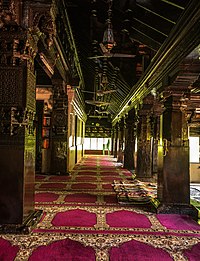Draft:Yusuf Bengali
| This is a draft article. It is a work in progress open to editing by anyone. Please ensure core content policies are met before publishing it as a live Wikipedia article. Find sources: Google (books · news · scholar · free images · WP refs) · FENS · JSTOR · TWL Last edited by UtherSRG (talk | contribs) 3 months ago. (Update)
Finished drafting? or |
Shattari | |
|---|---|
| Muslim leader | |
| Teacher | Wajihuddin Alvi |
| Based in | Ahmedabad |
Students | |
Influenced by | |
| Part of a series on |
| Islam in India |
|---|
 |
Background
Yusuf originated from
the subcontinent for further Islamic studies, eventually becoming a student and disciple of Wajihuddin Alvi, who was also the teacher of Usman Bengali.[4] After gaining sufficient training from Alvi, he was permitted to migrate to Burhanpur where he maintained a khanqah as well as a madrasa.[5][3]
Yusuf became one of the most prominent scholars of the
Lakhnauti.[3] Pir Muhammad bin Abdul Halim was a longtime student of Yusuf, and Isa Burhanpuri was another notable student of Yusuf Bengali. Yusuf would also circumcise Muslim children after their birth, and most notably, Yusuf circumcised Sakah Ji Burhanpuri who would later become a leading Islamic scholar in Burhanpur.[6] Although Yusuf had many students, he did not accept anyone to be his murid (disciple), and instead directed his followers to his contemporary Tahir Yusuf Sindhi. He also had the same mentality for his two sons, Abdullah and Abdur-Rahman, both of whom became disciples of Sindhi.[4]
Spiritual genealogy
Yusuf was a disciple of Wajihuddin Alvi.[2]
See also
- Usman Bengali, another 16th-century Bengali Muslim scholar who moved to North India
References
- ^ al-Lucknawi (1999), p. 505.
- ^ a b Ghazi, Syed Abdullah Shah, Hazrat Shah Muhammad Ghous Gwalior, India
- ^ a b c Quddusi, Mohammad Ilyas (2002). Khandesh Under the Mughals, 1601-1724 A.D.: Mainly Based on Persian Sources. New Delhi: Islamic Wonders Bureau. pp. 122–136.
- ^ a b (۶۰۸) یاد شیخ یوسف بنگالی رحمہ اللہ. Gulzar-e-Abrar (in Urdu). pp. 358–359.
- ^ Qazi Moin Uddin Ahmad (1963). History of the Shattari Silsila. Aligarh Muslim University. pp. 140–141, 272.
- ^ al-Lucknawi (1999), p. 534.
Bibliography
- al-Lucknawi, Abd al-Hayy (1999). Nuzhat al-khawatir (in Arabic). Beirut, Lebanon: Dar Ibn Hazm.
This page will be placed in the following categories if it is moved to the
article namespace.
Categories:

